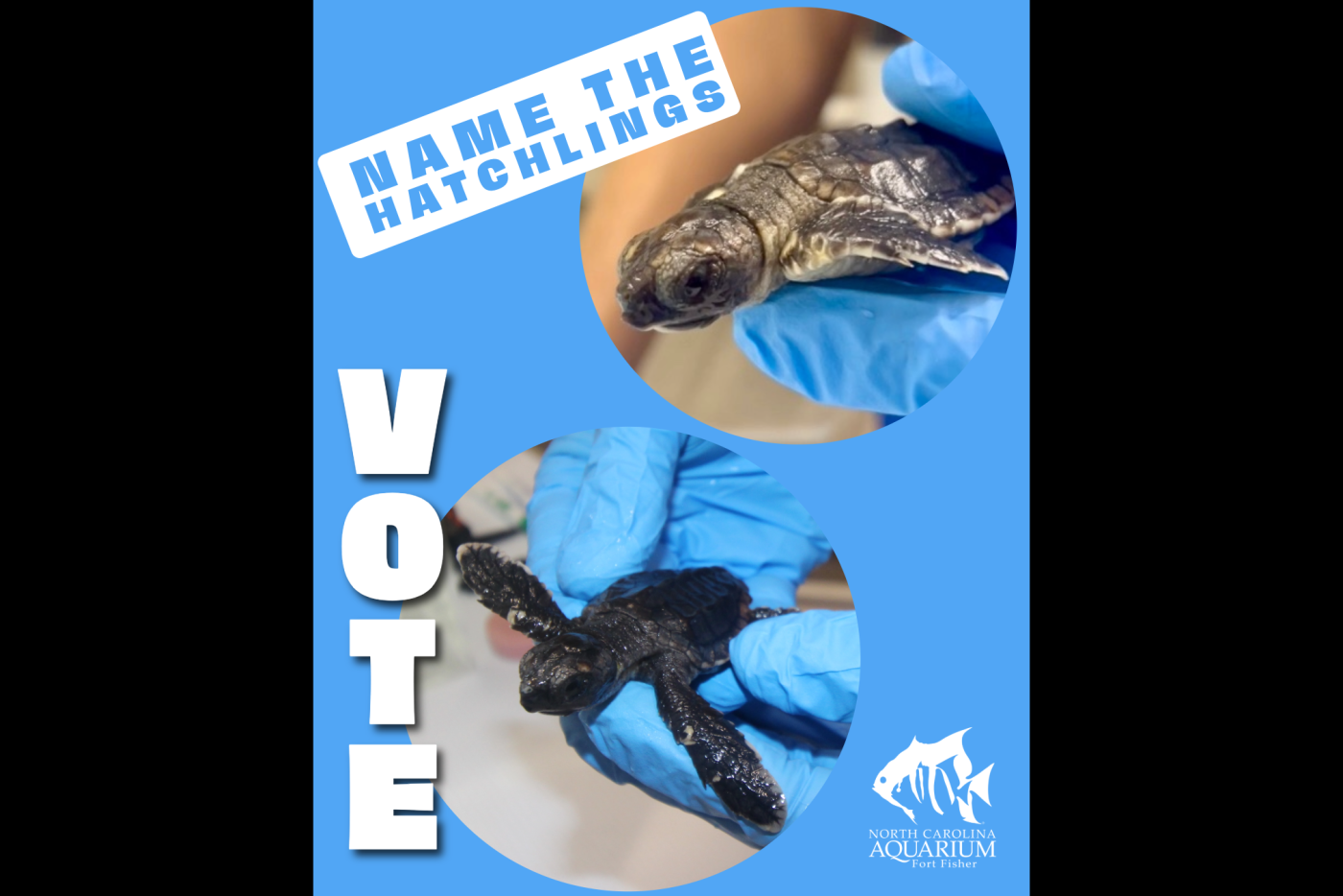Two loggerhead sea turtle hatchlings are in the house at the North Carolina Aquarium at Fort Fisher (NCAFF) this fall and the community has one job – to name these amazing ambassadors for ocean conservation. One hatchling came from Fort Fisher and one from Carolina Beach. They did not make the initial trek to the ocean during the nest hatching. The Aquarium is a division of the North Carolina Department of Natural and Cultural Resources which oversees the state’s resources for the arts, history, libraries and nature.
Aquarium team members and sea turtle volunteers excavate the nests 72 hours after a hatching which sometimes yields stragglers. NCAFF welcomes two of these hatchlings every year as ambassadors in the Loggerhead Sea Turtle Conservation habitat.
“We’re excited to welcome these loggerhead sea turtles to the Aquarium, inspiring the community to join our mission to protect them,” said Andrew Johnson, NCAFF aquarist. “They debut in the habitat as tiny survivors and stay with us until they become yearlings, and along this journey, create connections for visitors that can last a lifetime,” he added.
Here's where the community comes in! NCAFF staff and volunteers have suggested a list with pairs of names which reflect attributes of loggerhead sea turtles, their habitat or history.
NAME OPTIONS
Option A — Waccamaw & Coharie
Waccamaw (Honoring the American Indians—the Waccamaw Siouan, whose tribal homeland is on the edge of Green Swamp about 37 miles from Wilmington, NC)
Coharie (Honoring the Coharie Indian Tribe presently in southeastern region of the State)
Option B — Harbor & Isla
Harbor (A place to find shelter, especially one protected from rough water.)
Isla (Spanish word for island.)
Option C — Cora & Kéya
Cora (Derived from “coral,” indirectly referencing their habitat and scientific name.)
Kéya (Lakota word for turtle — a sacred figure in Lakota symbolism as it represents Mother Earth and the spirit represents the guardian of life, longevity and fortitude.)
Option D — Yaupon & Coquina
Yaupon (Tree native to Carolina Beach and Fort Fisher.)
Coquina (Soft rock made of shells buried under the sand-Fort Fisher is the northernmost location where it is found.)
Option E — Beacon & Buoy
Beacon (A light or other visible object serving as a signal, warning or guide at sea. Inspired by our hatchling program being a beacon of hope for conservation of the species.)
Buoy (An anchored float serving as a navigation mark to show reefs or for mooring. Inspired by the hatchlings often floating at the surface like a buoy in their first few months.)
Option F — Takoda & Ama
Takoda (Sioux for "friend to all".)
Ama (Cherokee name for “water”, honoring Native American linguistic and cultural ties to the region.)
Option G — Percy & Capri
Percy (Short for "Perseids", a meteor shower that was active during the time of their hatching.)
Capri (Short for "alpha Capricornids", a meteor shower that was active during their hatching.)
Option H — Nova & Astral
Nova (Meaning “new star”, symbolizing their bright future.)
Astral (Meaning of, connected with or resembling the stars.)
Option I — Azure & Sable
Azure (Inspired by the beautiful blue hues of the sea.)
Sable (After the dark color of some sea turtle shells, signifying elegance and strength.)
A LITTLE MORE ABOUT THE HATCHLINGS
Hatchling #1
- Laid on Carolina Beach May 22
- Nest Hatched July 18
- Nest Excavated July 21
Hatchling #2 Facts
- Laid on Fort Fisher May 31
- Nest Hatched July 25
- Nest Excavated July 28
HERE'S HOW TO VOTE
Head to the Aquarium to vote in-person or to the NCAFF socials to click and cast your vote on these platforms: Facebook, Instagram, Threads and LinkedIn. Deadline to vote is Friday, Aug. 22 at noon.
SCHOOL CHILDREN VOTE TOO
Following the community vote, the Aquarium will share a list of the top five pairs of names with students in the Adopt-a-Sea-Turtle program to vote on their favorite names for the hatchling pair. The Aquarium will announce the winning names on social media on Tuesday, Sept. 2.
RESERVE TICKETS
Visitors planning to head to the Aquarium for a visit and to vote in person should reserve their tickets online at NCAFF Tickets. Online reservations are required to visit the Aquarium. Visitors will have an opportunity to say farewell to Maris and Atlas, loggerhead sea turtle yearlings, who staff will release to the ocean this fall.
About the North Carolina Aquarium at Fort Fisher
The North Carolina Aquarium at Fort Fisher is just south of Kure Beach, a short drive from Wilmington on U.S. 421 and less than a mile from the Fort Fisher ferry terminal. The Aquarium is one of three Aquariums and a pier that make up the North Carolina Aquariums, a division of the Department of Natural and Cultural Resources. The mission of the Aquarium is to inspire appreciation and conservation of our aquatic environments. The Aquarium features a 235-000-gallon sand tiger shark habitat, an albino alligator, a bald eagle, a loggerhead sea turtle habitat and two families of mischievous Asian small-clawed otters.
Hours: 9 a.m. to 5 p.m. daily. Admission: $15 ages 13-61; $13 children ages 3-12; $14 seniors (62 and older) and military with valid identification; NC EBT card holders: $3. Free admission for children 2 and younger and N.C. Aquarium Society members and N.C. Zoo members. *EBT rate is applicable to a maximum of four tickets.
About the North Carolina Department of Natural and Cultural Resources
The N.C. Department of Natural and Cultural Resources (DNCR) manages, promotes, and enhances the things that people love about North Carolina – its diverse arts and culture, rich history, and spectacular natural areas. Through its programs, the department enhances education, stimulates economic development, improves public health, expands accessibility, and strengthens community resiliency.

